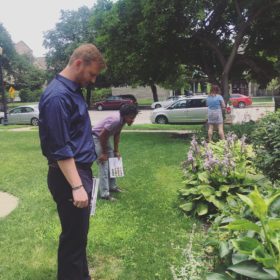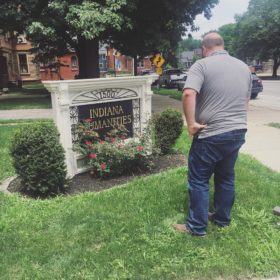Count those Pollinators!
July 3, 2018At Indiana Humanities we love to cross the worlds of the humanities and science—so Quantum Leap! Our Indiana Humanities team took a break from work in the office and became…
At Indiana Humanities we love to cross the worlds of the humanities and science—so Quantum Leap! Our Indiana Humanities team took a break from work in the office and became citizen scientists for the afternoon through participating in the Pollinator Count by Keep Indianapolis Beautiful. We each had our own pollinator sheet and observed a plant for four minutes, tracking which insects landed on the plant to pollinate it. At the end of the four minutes, the sheets we used to count were turned in and sent to KIB to add it to the other data and measure it. It’s that easy to be a citizen scientist!

Citizen science is research conducted by everyday people like you and me that is then used by professional scientists in their work. It collects data quickly and efficiently, and covers more space than one person could in years! Not only is it fun, interesting and simple, it also benefits the entire science community.
Pollinator Count, a month long event by Keep Indianapolis Beautiful is a great way you can get involved in citizen science, raise awareness of native species and recognize the importance of pollinators right here in Indiana. It only takes four minutes, plus you can take it with you wherever you go across the state, and it gives you an excuse to get outside!
Want to put on your own science cap? Follow these simple instructions:
- Download the iNaturalist App or the Pollinator Count Tool Kit on the Keep Indianapolis Beautiful website.
- Get outside and count some pollinators! All of the details and instructions are provided for you.
- Invite your friends, coworkers, and family to join in!
- Attend some of the other events in honor of Pollinator Count.

Have an interest in pollinators and citizen science? Join us for a Quantum Leap Field Trip to the Purdue Entomology Labs where we will learn about efforts to create an “Indiana Queen,” how to counter colony collapse and the reasons why humans and bees need each other.
This post was written by Julia Bartusek, a grants and program intern.


